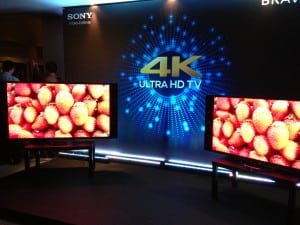ESPN Exec: No Plans for Separate Ultra-HD Channel
[Via Satellite 08-20-13] While the excitement around Ultra High Definition Television (UHDTV) continues to grow, the scars left by the failure of 3-D TV are causing the broadcasting industry to proceed with extreme caution when it comes to adopting UHDTV. But there is no doubt that the format is considered the next-generation high-resolution video, and analysts project 10 million homes worldwide will own an UHDTV set by 2016.
Television networks have already started working experimentally with Ultra-HD. While ESPN recently cancelled its 3-D TV channel, the network began showing Ultra-HD content on its HDTV channels, ESPN currently has no plans to produce a separate UHDTV channel, according to Chuck Pagano, executive vice president and CTO at ESPN in an exclusive interview with SatelliteTODAY.com. In addition, satellite providers such as Dish and DirectTV, have not yet asked the network for an UHDTV channel, Pagano added.
Ericsson and Intelsat recently demonstrated true 4K, end-to-end video transmission via satellite, marking the first broadcast of an Ultra-HD signal via satellite in North America. During the demonstration, Intelsat’s Galaxy 13 satellite delivered a 4:2:2 10-bit, 4K Ultra-HD signal at 60 frames per second. The 100 Mbps video feed was encoded and decoded in real time by Ericsson, using its AVP 2000 contribution encoders and RX8200 receivers, capable of 4K Ultra-HD operations as well as HD and SD contribution at the highest quality.
“The collaboration showed that we could transmit an Ultra-HD signal over satellite. We can accommodate the next-generation signals as soon as broadcasters are ready to offer them,” said Matthew Goldman, senior vice president, TV compression technology at Ericsson. “Commercial broadcasters may not begin to procure bandwidth for 4K broadcasts until 2015, at the earliest. It could even be longer,” he said.
But in the same manner as UHDTV, 3-D TV was projected to be successful. However, the market for the technology showed to be stagnant, leading to the end of ESPN’s 3-D channel. While this technology had several reasons for not taking off as projected, such as the necessity of 3-D glasses, Goldman doesn’t expect UHDTV to face the same challenges as 3-D TV. “There is a percentage of the population who cannot see [3-D TV]. Some people did not like the way it looked. With Ultra HD, those issues do not exist. It’s a natural extension. If you have normal human vision, you do not need extra glasses to see it,” he said.
But even though adopters of the new technology will not need to wear equipment to use it, there are other areas of concern that mirror issues with 3-D TV, including minimal content and high costs. On the low end of the cost spectrum is Sony’s 55-inch XBR 55X900A, which sells for $4,000. Other sets, such as Samsung’s 85-inch UN85S9AF, are more than $30,000. Nevertheless, David Mercer, vice president & principal analyst at Strategy Analytics, expects display prices to rapidly fall. “We fully expect UHDTV ultimately to do to HDTV what [High Definition Television] HDTV has done to standard definition over the past twenty years,” he said in a written statement.
However, fans of the technology already question the availability of varied and affordable content for these television sets. Although there are several Ultra-HD media streamers on the market, the equipment adds an additional cost to the already expensive technology. Sony’s 4K Ultra-HD media player offers Ultra-HD movies at $29.99, with movie rentals starting at $7.99. Thus, video streaming, along with demos provided by television manufacturers, may be the only content solution for the time being as a new television format may take a year’s time to become mainstream, as seen with HD adoption.
Still, according to a study released by the Consumer Electronics Association (CEA), Ultra-HD is expected to see increased adoption as consumers become more familiar with the technology, manufacturers reduce prices, and content providers embrace the format. While the idea of enhanced viewing may entice consumers, it seems the United States will proceed with caution for the next few years.
